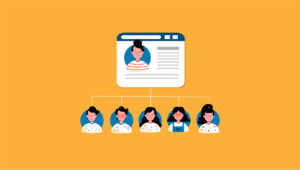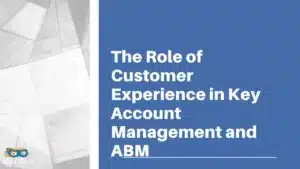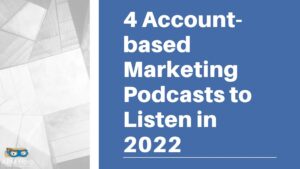Are you looking forward to starting an account-based marketing campaign but are not certain where to begin?
Here are 5 steps to get you started:
Define Your Target Account List
Who are your ideal customers?
To be successful with account-based marketing, it is essential to know your ideal customers. You need to tailor your marketing efforts to specifically generate the best results for your clients.
Without knowing who your ideal customers are, it would be difficult to create targeted campaigns that would be effective in reaching them.
Additionally, it is important to know your ideal customers to identify the best accounts to target for your account-based marketing efforts.
By knowing who your ideal customers are, you can easily find and target the accounts that are most likely to be receptive to your marketing messages.
Common Mistakes in Identifying Your Ideal Customers
There are several common mistakes that companies make when creating buyer personas. One of the most common mistakes is failing to include enough detail in the persona.
A persona should include not only the basic demographic information but also information about the buyer’s needs, wants, and motivations. Without this level of detail, the persona is likely to be inaccurate and not useful for marketing or sales purposes.
Another common mistake is creating personas that are too narrowly focused. A persona should represent a significant portion of the target market, not just a small segment.
For example, a persona for a luxury car might be too narrow if it only represents high-income buyers. A more effective persona would include a wider range of buyers, such as the middle class and other participants in its vast economic profile.
Research Your Accounts
What are their specific pain points?
There are a few key ways to determine your ideal customers in account-based marketing.
First, you’ll want to consider what type of business they operate. Is it B2B or B2C? The industry they are in, and size of the company.
These factors can help you narrow down your customer base and determine who would be the best fit for your products or services.

Next, you’ll want to consider what needs or pain points your ideal customers have that your product or service can solve. What are their goals and objectives? What challenges are they facing? Answering these questions can help you create targeted content and messaging that will resonate with your ideal customers.
There are many common pain points that clients experience when it comes to Account-based marketing campaigns.
One of the most common is the lack of understanding of what account-based marketing is and how it can be used to benefit their business.
Other common pain points include the lack of a clear and concise strategy, not knowing how to measure success, and not having the right tools and processes in place. Account-based marketing can be an extremely effective way to market to and win new business from key accounts.
However, in order to be successful, it is important to have a clear understanding of what it is and how it works. Without this understanding, it can be difficult to develop an effective strategy and measure success.
Common Mistakes in Identifying Customer Pain Points
There are several common mistakes that companies make when trying to identify the pain points of their buyers. One of the most common mistakes is failing to understand the buyer’s journey.
The buyer’s journey is the process that buyers go through when making a purchase decision. It includes stages such as awareness, considerations, and decisions. Companies need to understand buyers’ actions and conclusions at each stage of the journey to identify their pain points.
Another common mistake is failing to understand the difference between needs and wants. Needs are things that are essential to the buyer, while wants are things that the buyer would like to have but can live without.
It’s important to understand the difference between the two because needs are based on function, while wants are based on emotion.
Create Personalized Content
What can you offer that will address your accounts’ pain points?
A recent study found that personalization can improve your account-based marketing strategies.
The study found that when companies personalize their account-based marketing campaigns, they are more likely to see an increase in sales and customer loyalty.
The study also found that personalization can help you target your account-based marketing campaigns more effectively and that it can also help you improve your overall marketing strategies.
There are a few key ways to make your content more personalized. First, consider who your target audience is and what their needs are. Then, craft your content in a way that appeals to those needs.
For instance, if you are to target young adults, your content should be engaging and easy to read. If you are to target a fully matured audience, your content should be more informative and comprehensive.
Another way to personalize your content is to use data to segment your audience and then create custom content for each segment. It allows you to get very specific with your messaging and ensure that each audience member is seeing content relevant to them. Finally, don’t forget to use images, videos, and other multimedia content to break up details into a coherent format.
Common Mistakes in Creating Personalized Content
Most companies think they can easily create content personalized to their customers’ pain points enough to address the problems.
However, this is not the case. To be efficient, the content must be well-crafted and relevant to the customer’s pain points.
In addition, the company should make certain to deliver the content to the customer suitably.
There are common mistakes that companies make when creating personalized content to address pain points. One of the most common mistakes is failing to segment their audience.
Without segmenting their audience, companies will not target their content properly. As a result, much of their content will miss the mark.
Another common mistake is creating content that is too generic. Generic content does not address the specific pain points resulting in inadequacy in solving their problems.
Finally, many companies make the mistake of not making their content engaging enough. If the content is not appealing, the customer is not likely to stick around long enough to see the solution offered.
Nurture Your Existing Customers
How can you stay top of mind with your ideal customers?
There are several ways to foster customer loyalty, and businesses should consider which methods are most applicable to their products, services, and industry. Some common approaches include providing exceptional customer service, offering valuable rewards programs, and delivering high-quality products. We covered an in-depth discussion on how to retain your customers by 70%on the other article. Check this out if you want to know more.
Customer loyalty is often driven by satisfaction with a company’s products or services. When customers have a positive experience with a business, they are more likely to continue patronizing it. Therefore, businesses should focus on providing quality products and services that meet customer needs and expectations.
Common Mistakes When Nurturing an Ideal Customer
Most companies make the mistake of thinking that they can retain their ideal customers simply by providing them with basic customer service. However, this is only part of the equation. To truly retain your ideal customers, you need to go above and beyond simply meeting their needs.
You need to anticipate their needs and provide them with solutions before they even know they have a problem. Additionally, you need to make sure that your ideal customers feel like they are part of your company’s story and that they are valued.
The best way to do this is to create a customer loyalty program that offers exclusive benefits and rewards to your most loyal customers. By making your ideal customers feel like they are part of your company’s story and providing them with unique service, you can expect that you will be on top of their minds when they look for something.
Measure Your Progress
Measure your success. What metrics will you use to track your account-based marketing campaign’s success?
If you don’t measure something, you can’t track it. This is a simple concept, but it’s important to understand to properly manage a business or organization.
Without accurate data, it’s impossible to make informed decisions about where to allocate resources or how to improve performance.
Imagine trying to drive to a destination without knowing how far away it is – you would never make it! The same is true for reaching business goals in account-based marketing campaign; without measuring progress, it’s impossible to know how close you are to achieving them.
We have a separate blog about the key ABM metrics you should keep an eye on.
By following these steps, you can launch an effective Account-based marketing campaign. What are the strategies that you missed out and what points resonate well to you? Let’s keep the conversation going by leaving a comment below.





